Sowing the Seeds of Wonder
November 8, 2019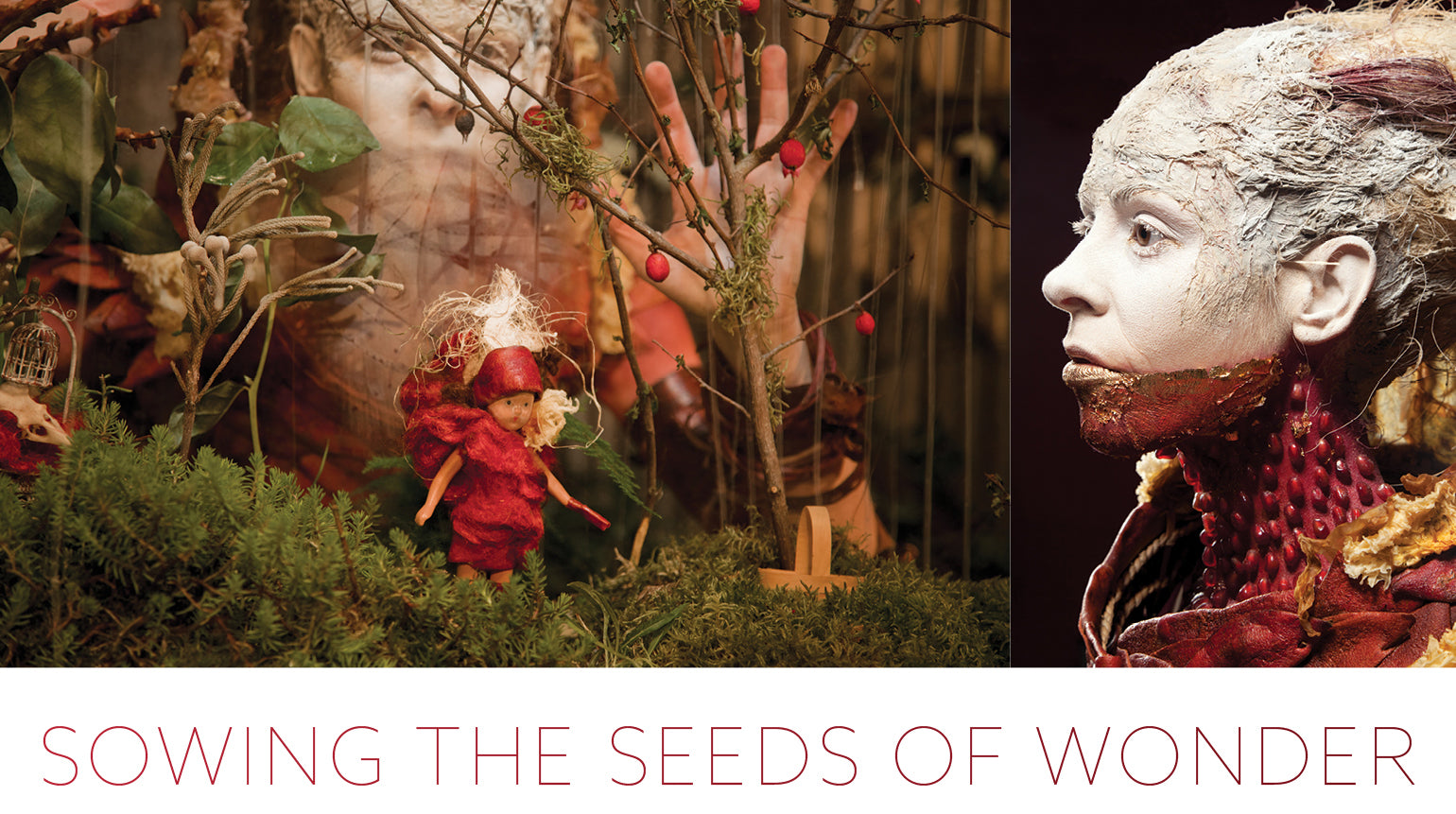
Emily Carr graduate Nicole Dextras is an award-winning Vancouver-based artist. She cleverly transforms natural materials into elaborate and highly imaginative costumes, characters and supernatural universes, promoting a message of self-sufficiency as an alternative method of sustainability.
Creating a sense of magic is kind of in my blood, and magic is something the world needs more of. I consider myself an environmental artist and feel we’ve lost our sense of hope – things seem so bleak with the way our politics are unfolding. We’re subjected to this constant barrage of negative statistics and it’s just pounding us down.
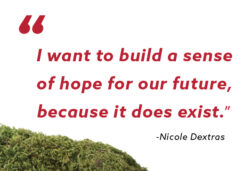
My background is in theatre design. For a very long time, I’ve had an interest in mythology and in essence, I’m a visual storyteller. I always imagine a narrative for the characters I create. I tend to work from an idea or theme and regard myself as a conceptual artist, but ironically, I rejected this genre when I was at Emily Carr in the 1980s. It seemed too cold and self-indulgent. I’ve found my own expression working with concepts but also expanding them to include public engagement.
Discovering new plants and experimenting with them is something I love. I’m constantly picking leaves, seeds and flowers and testing the rate of wilting and drying. Some plants like lilac petals wilt very fast, but I managed to make a coat with them by adding the flowers the night before the photo shoot. It was a bit crazy but smelled wonderful. I also love to research native botany and its uses. Awareness of nature can provide a direct connection with our ecosystem, making us more sensitive to environmental issues. This understanding has the benefit of reminding us that there’s already a wealth of knowledge out there which can encourage more self-sustainable lifestyles.
I always envision these fantastical places I dream of going to, or I’ll see things online and think, ‘Oh my god, I wish I was in Slovenia in this abandoned circus!’, but I don’t usually have that option. Vancouver is such a new city and scouting for locations is difficult. It doesn’t have a lot of interesting places, so I’ve been doing the best that I can with what I have.
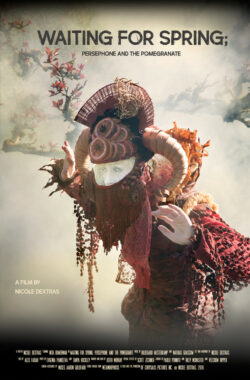
Poster of Nicole Dextras’ poster Waiting for Spring
Other people who make fantasy often green screen or animate, but I want to be in a real world. My film Waiting For Spring is set in a dystopian future where climate change has exacerbated forest fires, drought and floods. A young woman named Persephone, clad in jacket made from pomegranate peels, uses her ingenuity to survive in an abandoned orchard. I’d already made the costume but thought, ‘I’m never going to find this location, I’m going to have to build it.’ I have a studio on Granville Island and got permission to use some space in a parking garage. They allowed me a day or two in a little section with no cars, so I could construct the set. Placing my characters in a convincing environment adds a whole other dimension which brings it to the point of magic.
I also make the props and am constantly feeding into the story. All the elements influence each other. With Waiting For Spring, the actual Greek myth was something which gave me a lot of inspiration. In developing the character, I decided she was in this universe, existing as a sole survivor. Then arose the question, ‘How is she coping emotionally and psychologically?’ I decided she was doing something very creative. The idea of the terrariums came in, where she would build these links to the past landscape when the earth was really abundant. She’d place herself in the scenery and make the creative connection. I wasn’t sure how I was going to realise this and ended up gathering a lot of materials and having a terrarium-building party with friends. They brought some props they felt like working with and we just played for a day. After that I had a table full of incredible little plant-worlds. It was a really nice exchange. This communal joy feeds me as an artist. It’s not something you can really do alone, and over time I’ve built a team of people who are really interested in the project and support me.
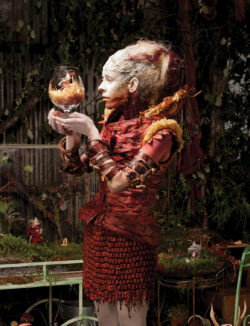
Video still from Waiting for Spring; Persephone and the Pomegranate by Nicole Dextras. Click to expand.
One piece of advice I’d give, would be to cultivate these relationships. I’ve been imagining these things for years, but was overwhelmed with the actual execution; that’s the biggest stumbling block. I didn’t go to film school and from what I saw, that’s where people made all the connections. It’s sort of your stepping stone. I thought, ‘Someone of my age isn’t going to film school, I’m not gonna do that, I hate school! How can I build these contacts?’ And then realised, ‘I already have.’ It’s just taken more time. It’s taken me maybe ten years to do it.
I’m trying to provide a ray of light and I think that light will grow. It’s starting to, a little bit. People are beginning to talk about environmental anxiety, and that’s something we as a society need to confront. Trying to solve problems with more facts and politics is difficult, but I think the arts offer a credible alternative. Of course you might be seen as living in fantasy, or not having your feet on the ground, or as being so pie in the sky that you’re not taken seriously, but somehow we need to find a way to focus on the positive things that are out there.
We have so much at our disposal. People are proposing lots of fantastic and interesting ways to tackle environmental problems right now, but for some reason these ideas aren’t making it to the top of the newsfeed. Instead, we’re sucked in by negative headlines. Our society is attracted to the drama and it drains the life right out of us. For the sake of the planet we’re going to have to figure out a way to rise above that.
In my next film, Chronos, I hope to emphasise this more. I’ll have a budget and a crew and will be able to highlight the survival aspect. The new character is thriving in a desert caused by draught. He’s gathering water from fog catchers. This technology collects dew to provide clean drinking water and actually exists. There’s an Italian architect who’s not only designed these devices but has done it in a really beautiful way. He’s been a real inspiration to me.
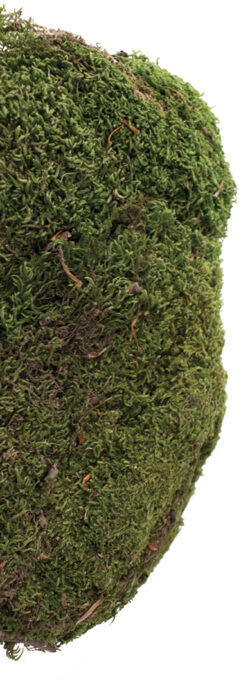
Magic and fantasy can be a form of escapism and a lot of science fiction is dystopian. I’m trying in my own small way to create an alternative to that. I find the image we’re bombarded with all the time is ‘We’re all going to be in rags’, ‘We’re all going to be zombies’, but I think, ‘No, we’ll be surviving beautifully! We’re going to be so cool and we’re going to be so fashionable and we can do this!’
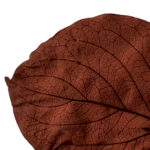 Opus is delighted to collaborate with Nicole Dextras in our holiday windows. Visit your local store to experience the magic firsthand.
Opus is delighted to collaborate with Nicole Dextras in our holiday windows. Visit your local store to experience the magic firsthand.
Support the artist!
An Indiegogo crowdfunding campaign in support of Nicole’s second film in the A Dressing the Future series, Chronos; Time of Sand, is underway until December 12, 2019. Chronos promotes hope about our ability to combat climate change with real solutions.
This crowdfunding campaign will support the shooting of key scenes in the sand dunes of a Canadian desert and rewards for support include high-quality Nicole Dextras art prints, one of which can be viewed at each Opus location until December 24th.
For more information, and to support Nicole’s next film, please visit Indiegogo: Chronos: Time of Sand – Short Film
